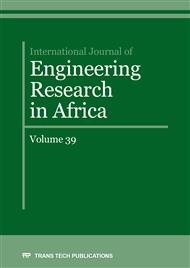[1]
Y. Miglis, S. H. Mark and X. Qi, Reliability Based ECA Flaw Acceptance Criteria and Safety Factors of Risers and Flowlines. ASME 2017 36th International Conference on Ocean, and Arctic Engineering, Volume 5B, Trondheim, Norway, June 25th-30th. Paper No: OMAE2017-61028, (2017).
DOI: 10.1115/omae2017-61028
Google Scholar
[2]
API American Petroleum Institute, General Overview of Subsea Production Systems, First Edition. API Technical Report 17TR13, API Publishing Services, Washington, DC, (2015).
Google Scholar
[3]
J. Chen, M. Duan and T. Kai, Dynamic Response and Fatigue Damage Analysis for Drilling Riser. Proceedings of 2012 International Conference on Mechanical Engineering and Material Science (MEMS), Atlantis Press, (2012).
DOI: 10.2991/mems.2012.99
Google Scholar
[4]
S. Laik, V. P. Sharma and R. L. Malhotra, Recent Trends in Exploration, Exploitation and Processing of Petroleum Resources. Tata McGraw-Hill Publishing Company Limited, New Delhi. ISBN: 9780070077287, (2009).
Google Scholar
[5]
Gate Energy, Introduction to Risers-Subsea Engineering, 2015 Gatekeeper. Houston, Texas, 77084, USA. [online] available at https://www.gateinc.com/gatekeeper/gat2004-gkp-2015-02, (2015).
Google Scholar
[6]
A. E. Ikpe, I. B. Owunna, P. O. Ebunilo and E. E. Ikpe, Feasibility Studies on Offshore Triceratops as Future Offshore Structure Using FMEA Approach. International Journal of Innovative Research and Development 5, 6 (2016) 104-113.
Google Scholar
[7]
A. Luppi, G. Cousin, and R. O'Sullian Deepwater Hybrid Riser Systems. Offshore Technology Conference, Asia, 25-28 March, Kuala Lumpur, Malaysia. Document ID: OTC-24802-MS, (2014).
Google Scholar
[8]
S. J. Liu, Y. H. Xie, J. Yang, R. E. Xie, C. Y. Zhang, H. C. Lin and Z. R, Peng, Drilling riser dynamic characteristics of marine deep water. Oil Drilling & Production Technology 31, (2009) 1-4.
Google Scholar
[9]
Y. J. Chang, G. M. Chen, Y. Y. Sun, L. B. Xu and P. Peng, Nonlinear dynamic analysis of deepwater drilling risers subjected to random loads, China Ocean Engeering 22, (2008) 683-691.
Google Scholar
[10]
Y. Bai, R. B. Charrya and M. E. McCormick, Elsevier Ocean Engineering Book Series Volume 3, Pipelines and Risers. Elsevier Science Limited, Oxford OX5 IGB, UK, ISBN: 0080437125, (2001).
DOI: 10.1016/s1571-9952(01)80012-x
Google Scholar
[11]
M. A. Gamino, FSI Methodology for Analyzing VIV on Subsea Pipeline Free Spans with Practical Boundary Conditions. Department of Mechanical Engineering Technology, University of Houston, (2013).
DOI: 10.1115/omae2013-10419
Google Scholar
[12]
N. Politis, H. Banon and C. Curran, HIPPS-Based No-Burst Design of Flowlines and Risers. Offshore Technology Conference, Houston, 30th April-3th May, Society of Petroleum Engineers, (2013).
DOI: 10.4043/22908-ms
Google Scholar
[13]
P. Collberg, Guideline on Design of Pipelines Systems with Over Pressure Protection System. Report No. 2010-9414, 12TB6X5-10, Det Norske Veritas (DNV), Oslo, Norway, (2010).
DOI: 10.3940/rina.mre.2010.01
Google Scholar
[14]
C.D. Adapco User guide: STAR-CCM+ Version 8.04 [online] available at http://cumoodle.coventry.ac.uk/course/view.php?id=15595, (2013).
Google Scholar
[15]
M. Sommerfeld, Numerical Methods for Dispersed Multiphase Flows. Advances in Mathematical Fluid Mechanics, 327-396. Springer International Publishing AG, ISBN: 9783319602820, (2017).
DOI: 10.1007/978-3-319-60282-0_6
Google Scholar
[16]
Q.C. Fu, Numerical Simulation of Pressure Loss in Large Size Annulus of Deeper Water Drilling Riser. Materia Science Forum 857, (2016) 590-597.
DOI: 10.4028/www.scientific.net/msf.857.590
Google Scholar
[17]
A.E. Ikpe, E. K. Orhorhoro and O. G. Ogiemudia, Computational Fluid Dynamics (CFD) Simulation in Air Duct Channels Using STAR CCM+. European Journal of Advances in Engineering and Technology 4, (2017) 216-220.
Google Scholar
[18]
R. Manivel, T. Babin, N. Sangeeta and V. Brathikan, Simulation of Two Phase Flows in Flexible M-shaped Jumper to Predict the Failure. Innovative Solutions in Flow Measurement and Control in Oil and Gas, August 28-30, FCRI, Palakkad, Kerela, India, (2017).
Google Scholar
[19]
A. Saieed, B. Sam, W. Pao, and F. M. Hashim, Numerical investigation of side arm gas volume fraction in two phase T-junction. Journal of Mechanical Engineering and Sciences (JMES) 10, (2016) 2311-2323.
DOI: 10.15282/jmes.10.3.2016.9.0215
Google Scholar


